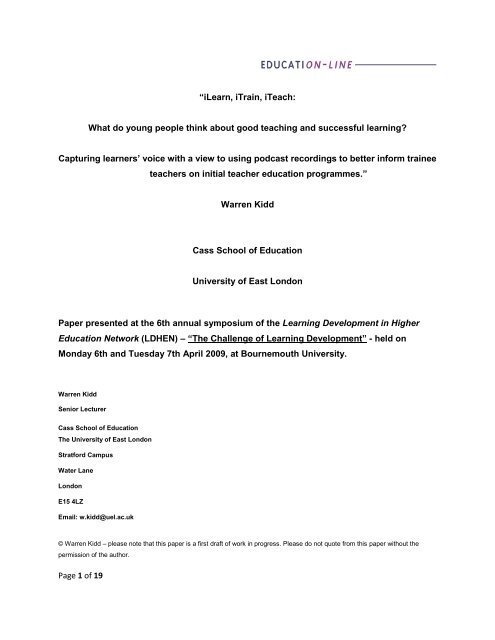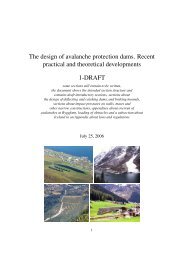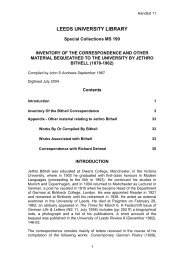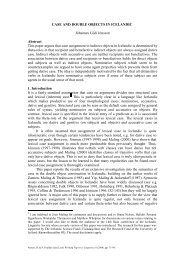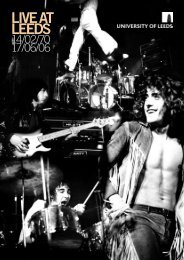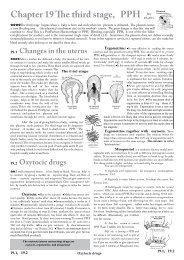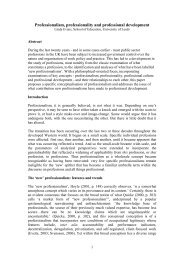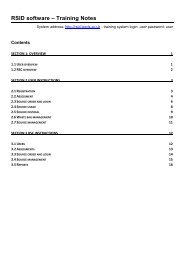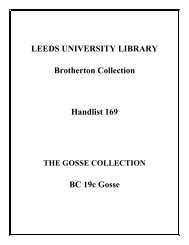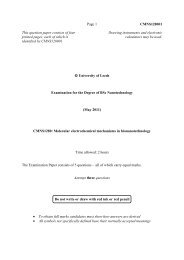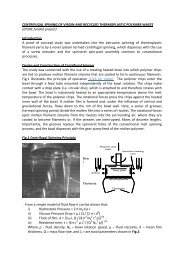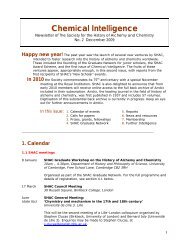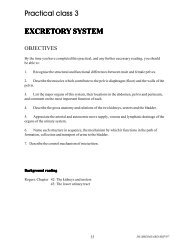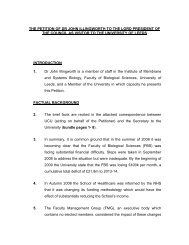“iLearn, iTrain, iTeach: - University of Leeds
“iLearn, iTrain, iTeach: - University of Leeds
“iLearn, iTrain, iTeach: - University of Leeds
You also want an ePaper? Increase the reach of your titles
YUMPU automatically turns print PDFs into web optimized ePapers that Google loves.
Page 1 <strong>of</strong> 19<br />
<strong>“iLearn</strong>, <strong>iTrain</strong>, <strong>iTeach</strong>:<br />
What do young people think about good teaching and successful learning?<br />
Capturing learners‟ voice with a view to using podcast recordings to better inform trainee<br />
teachers on initial teacher education programmes.”<br />
Warren Kidd<br />
Cass School <strong>of</strong> Education<br />
<strong>University</strong> <strong>of</strong> East London<br />
Paper presented at the 6th annual symposium <strong>of</strong> the Learning Development in Higher<br />
Education Network (LDHEN) – “The Challenge <strong>of</strong> Learning Development” - held on<br />
Monday 6th and Tuesday 7th April 2009, at Bournemouth <strong>University</strong>.<br />
Warren Kidd<br />
Senior Lecturer<br />
Cass School <strong>of</strong> Education<br />
The <strong>University</strong> <strong>of</strong> East London<br />
Stratford Campus<br />
Water Lane<br />
London<br />
E15 4LZ<br />
Email: w.kidd@uel.ac.uk<br />
© Warren Kidd – please note that this paper is a first draft <strong>of</strong> work in progress. Please do not quote from this paper without the<br />
permission <strong>of</strong> the author.
Abstract<br />
What do young people think about good teaching and successful learning, and how do<br />
they articulate these views?<br />
How can audio <strong>of</strong> these views be captured to enable capacity building and e-learning on<br />
post-16 teacher training programmes?<br />
In an attempt to build a digital teaching resource taking account <strong>of</strong> podcasting emergent<br />
technologies, this project has captured audio recordings via unstructured interviews <strong>of</strong> young<br />
people aged 16 - 18 in Essex, Kent and London talking about „good teaching‟ and „good<br />
teachers‟. These recordings are being used as part <strong>of</strong> a blended delivery during trainee teacher<br />
induction to aid reflection and discursive practices. The recordings represent for the institutions<br />
taking part an attempt to capture the learner voice and to generate stimulus materials designed<br />
to support staff training, self-evaluation and action research. The story <strong>of</strong> the research is not yet<br />
fully formed, being at a mid point. The digital resource has been created, and the next step is to<br />
capture how institutions might use the data for their own purposes. The session accompanying<br />
this paper will look at the findings to date, drawing heavily upon the use <strong>of</strong> audio clips.<br />
This paper is an attempt to articulate three key themes:<br />
� To illustrate how podcasting teaching tools can be used with trainee teachers within a<br />
Page 2 <strong>of</strong> 19<br />
Higher Education context and to reflect upon and evaluate my creation and development<br />
<strong>of</strong> this e-learning resource;<br />
� To develop a commentary on the fears and anxieties <strong>of</strong> teachers-in-the-making<br />
regarding their own learners;<br />
� To give a voice to the thoughts that young learners (aged 16-18) have about „good<br />
teaching‟.
This is a work in progress. It is at a mid-stage between resource construction/piloting, and we<br />
are now waiting until next academic year to fully use and explore the digital resource and<br />
archive materials now recorded.<br />
Introduction: A context <strong>of</strong> „non-situated learning’<br />
My own recent experience <strong>of</strong> joining the Post-Compulsory Education and Training (PCET)<br />
teacher education team at the <strong>University</strong> <strong>of</strong> East London (UEL), shows that many <strong>of</strong> the trainee<br />
teachers in initial teacher education arrive at the start <strong>of</strong> their programmes without much contact<br />
with younger learners. Thus, they are <strong>of</strong>ten surprised by the degrees <strong>of</strong> confidence, reflection<br />
and articulation with which many younger learners are able to engage with their own learning.<br />
They are surprised at how learners are able to talk confidently about what they think is good<br />
teaching and to be able to describe in some depth and with sophistication styles <strong>of</strong> teaching and<br />
teaching tools and techniques. At the same time, many trainees are understandably cautious<br />
and concerned about the teaching role – in particular over issues <strong>of</strong> classroom and behaviour<br />
management, <strong>of</strong>ten clouded by their (mis)perceptions <strong>of</strong> what younger learners (aged 14 – 19)<br />
are like.<br />
As a teaching team we spend a great deal <strong>of</strong> time during the induction period <strong>of</strong> the PGCE<br />
PCET concentrating upon issues <strong>of</strong> pr<strong>of</strong>essional identity, reflection as a pr<strong>of</strong>essional learning<br />
tool, and new for this academic year, the socio-economic context within which colleges local to<br />
the university work. The teaching team have also newly adopted a „Reflective Journal‟, piloted<br />
for this academic year, to allow and encourage trainees to formally express their ongoing and<br />
changing pr<strong>of</strong>essional identity and to encourage the recording <strong>of</strong> critical incidents and lesson<br />
self-reflections and evaluations. Some <strong>of</strong> this content is formally assessed since it makes up<br />
part <strong>of</strong> marked assignments, but a great deal is there for the self-reflection and pr<strong>of</strong>essional<br />
learning <strong>of</strong> the individual involved.<br />
In a sense, until the trainees get to visit colleges and meet learners, this learning is highly<br />
„unsituated‟. This is both a pedagogic and pr<strong>of</strong>essional issue – how do trainees as<br />
Page 3 <strong>of</strong> 19
pr<strong>of</strong>essionals-in-the-making come to develop a sensitivity towards their learners and towards<br />
the mechanics and craft <strong>of</strong> teaching and learning itself? Equally, how can we, as teacher<br />
educators, model best practice in supporting trainees in this crucial initial development?<br />
Extracts from the Reflective Journals (quoted here with permission <strong>of</strong> the trainees themselves)<br />
express clearly the ambiguous location <strong>of</strong> many between excitement and fear; between valuing<br />
wanting to „change lives‟ and being worried about the „nature‟ <strong>of</strong> the lives <strong>of</strong> their younger<br />
learners:<br />
“When I arrived at a local sixth form to have a look around I felt a little intimidated, as my<br />
experiences <strong>of</strong> sixth form were very different studying in middle class York. However, during our<br />
tour I saw nothing but eager, hardworking students who were all focussed and seemingly<br />
interested in what they were learning. I had half expected to walk past classrooms and see<br />
students running around, shouting, fighting and generally getting out <strong>of</strong> hand…”<br />
“…in light <strong>of</strong> some <strong>of</strong> the early discussions on my PGCE I was worried that I had been too naïve<br />
about the challenges <strong>of</strong> teaching in FE colleges, particularly in Newham, and was left wondering<br />
if this was the right path for me after all…”<br />
“As my choice to come to UEL was mainly based on the fact that I would be studying and<br />
working in east London, the introduction to the socio-economic "peculiars" <strong>of</strong> the local area was<br />
<strong>of</strong> no surprise or shock. As I looked around the room I wondered how many in the group had a<br />
similar point <strong>of</strong> view (I'm guessing and hoping the majority) and how many might end up<br />
struggling to deal with East End's "deprived youth". One <strong>of</strong> course does not negate the other,<br />
and I suspect I too will find it rather challenging at times – despite all my good intentions and<br />
genuine interest in giving my students the best possible opportunities”<br />
Once they have started their teaching placement, this hope for young learners can sometimes<br />
all too quickly become frustration:<br />
“I have an issue with student‟s complete inability to work independently or for themselves. In<br />
many lessons it feels as through students would prefer me to just give them definitions <strong>of</strong><br />
Page 4 <strong>of</strong> 19
keywords and tell them to memorise. The idea <strong>of</strong> building skills for themselves seems beyond<br />
them.”<br />
On recalling the group‟s induction walk along the east London „Docklands‟ area <strong>of</strong> the Thames,<br />
one trainee reflects:<br />
“...The walk from Canary Wharf along the river to just east <strong>of</strong> Tower Bridge was a good addition,<br />
as it said plenty about what the area used to be like (warehouses etc) and what it is like now<br />
(posh flats, gated communities). It is in stark contrast to most <strong>of</strong> the rest <strong>of</strong> east London – as a<br />
walk to Shadwell station reminded us later – but the gated communities and riverside<br />
apartments could have as much an effect on the lives <strong>of</strong> East London's young people as the<br />
council estates and tower blocks <strong>of</strong> Bow and Poplar. I can only try and guess what that effect<br />
might be at this point (anger? resentment? feeling <strong>of</strong> worthlessness? Who knows…) but I<br />
suspect I might find out once I start my placement!”<br />
Many <strong>of</strong> the trainees (as indeed do many teachers) find themselves occupying highly contested<br />
and ambiguous relationships with their learners:<br />
“I feel that I need to challenge them, and help broaden their horizons and their aspirations. Even<br />
if it needs to be done while they are kicking and screaming...”<br />
“My opinion varies - They are sweet and lovely, smart and enthusiastic, frustrating and hard<br />
work, stubborn and disrespectful. They can reduce you to tears in one lesson, but amaze you<br />
with their creativity and enthusiasm two days later. They are given a hard time by the media and<br />
the police - twice in the last four days I witnessed the police stop and search my students, once<br />
at the tube station and once outside the theatre. Their lives are not easy, or fair, and yet they<br />
sometimes seem resigned to their fate. I think they are scared <strong>of</strong> what they don't know, so<br />
choose to dismiss it and stick to their small (and safe) known worlds. I find teaching them hard<br />
Page 5 <strong>of</strong> 19
work, but also extremely rewarding when they 'get it'. I feel it's a greater duty to do the absolute<br />
best I can and give it my all”<br />
“Students do have the ability to surprise you. Some students appear quite unmotivated until you<br />
get to know them and they turn out to be amongst the best students.”<br />
Within all these hopes, fears, insecurities and frustrations, the importance <strong>of</strong> the induction<br />
period into the initial teacher education programme becomes paramount. The induction<br />
becomes about the recognition on behalf <strong>of</strong> the trainee that the construction <strong>of</strong> their pr<strong>of</strong>essional<br />
identity and self is about to undergo rapid transformation. The induction period becomes an<br />
attempt to turn this reflection into more situated learning – to contextualise first visits to<br />
placements and first contacts with learners within boarder brush strokes. It is this research<br />
problematic that has lead to the construction <strong>of</strong> the learner voice podcasting resource that this<br />
paper addresses:<br />
How can we give a voice to the learner that can be better understood by the trainee teacher?<br />
Talking audio; talking podcasting<br />
The term e-Learning 2.0 is used to refer to new ways <strong>of</strong> thinking about e-learning inspired by the<br />
emergence <strong>of</strong> Web 2.0 technologies, tools, s<strong>of</strong>tware and platforms. This new e(nhanced)-<br />
learning places increased emphasis on social learning and the use <strong>of</strong> social networking and<br />
social s<strong>of</strong>tware such as blogs, wikis, podcasts and virtual worlds such as „second life‟. Web 2.0<br />
is a recognition that the virtual world <strong>of</strong> high-speed communications technology has moved on –<br />
and it has moved on due to very changes in the technology itself: how it maps together, how it<br />
works outside <strong>of</strong> „real time‟ and how users adopt tools with fluidity and „intuitive‟ flair the more<br />
exposed we become. The growth <strong>of</strong> users, increased interconnected interactivity <strong>of</strong> new internet<br />
tools and the affordability and availability <strong>of</strong> broadband „always-on‟ internet connections, has led<br />
Page 6 <strong>of</strong> 19
to what we refer to as a Web 2.0. The Teaching and Learning Research Project (TLRP) refer to<br />
four distinctive features <strong>of</strong> the value <strong>of</strong> Web 2.0 technologies – the playful, the expressive, the<br />
reflective and the exploratory (Selwyn, 2008).<br />
Within the literature there are claims made by some that we are experiencing a polarization <strong>of</strong><br />
the „digital native‟ and the „digital immigrant‟ (Prensky, 2001). Based upon factors such as<br />
accessibility, affordability and submersion, it is the post-1993 generation who are most <strong>of</strong>ten<br />
seen to be the first true „digital natives‟ – they are currently in year 10 <strong>of</strong> their secondary schools<br />
and have just started to study for GCSEs. There is also some talk <strong>of</strong> the „new actor‟ within<br />
cultural and educational dynamics and global change (Veen and Vrakking, 2006). Equally, it is<br />
claimed that we are witnessing the „rise <strong>of</strong> the homo zappien‟: a mouse in one hand, a<br />
keyboard/PDA/MP3 player in the other. Clicking and zapping their way through a media<br />
saturated reality where learning is fast paced, immediate and social in nature (see Veen and<br />
Vrakking, 2006).<br />
Within this rise <strong>of</strong> Web 2.0, podcasting technologies and tools are themselves a phenomenon <strong>of</strong><br />
growth in their own right – and an example <strong>of</strong> the very „social‟ and rich-media „time-shifting‟<br />
cultural and leisure practices that the notion <strong>of</strong> Web 2.0 represents. There is now a growing<br />
body <strong>of</strong> literature that has attempted to illustrate the value <strong>of</strong> podcasing as an educational tool<br />
rather than simply a leisure-time phenomenon (see Maag, 2006 and Freedman, 2006). There<br />
are also the beginnings <strong>of</strong> a debate locating podcasting and the modelling <strong>of</strong> its use within<br />
discussions <strong>of</strong> initial „pre-service‟ teacher education (see Souter and Muir, 2008).<br />
Ideal type <strong>of</strong> a podcast<br />
So what are podcasts and what is podcasting?<br />
JISC (2005) define the term „podcast‟ as “publishing <strong>of</strong> sound files on the internet. Users<br />
subscribe to podcasting via designated s<strong>of</strong>tware.” (JISC, 2005: 57)<br />
To use one popularist Web 2.0 phenomena to define another, the wikipedia definition <strong>of</strong> a<br />
podcast (accessed January, 2009) reads:<br />
Page 7 <strong>of</strong> 19
“A podcast is a series <strong>of</strong> audio or video digital media files which is distributed over the Internet<br />
by syndicated download, through Web feeds, to portable media players and personal<br />
computers. Though the same content may also be made available by direct download or<br />
streaming, a podcast is distinguished from most other digital media formats by its ability to be<br />
syndicated, subscribed to, and downloaded automatically when new content is added. Like the<br />
term broadcast, podcast can refer either to the series <strong>of</strong> content itself or to the method by which<br />
it is syndicated; the latter is also called podcasting.”<br />
And a final, third definition reads -<br />
“Podcasting is a generic name for a method <strong>of</strong> distributing audio and other multimedia files over<br />
the Internet for playback on mobile devices and personal computers. Although this type <strong>of</strong><br />
content has long been available on Web pages, a podcast is usually defined by its ability to be<br />
automatically downloaded to a user‟s computer by subscription. That electronic file can then be<br />
easily transferred to an iPod or other portable audio player and listened to at any time.” (Curto,<br />
2006)<br />
Strictly speaking then, I have found it useful to think <strong>of</strong> a podcast as comprising the following<br />
ideal-typical elements:<br />
1. Audio file (video files are referred to as a „vodcast‟);<br />
2. Playable through an iPod media player;<br />
3. Playable through any MP3 or WMP player;<br />
4. Downloaded from the internet;<br />
5. Produced using an RSS (Really Simple Syndication) Feed allowing automatic<br />
Page 8 <strong>of</strong> 19<br />
downloading;<br />
6. The listener can subscribe to a series <strong>of</strong> recordings – thus making them „automatic‟ as<br />
above.
Within this ideal-typical formation, and most commonly, most „podcasts‟ are not solely for the<br />
purpose <strong>of</strong> the iPod (from where the phenomenon derived its name), and in the case <strong>of</strong> my own,<br />
„podcasts‟ do not necessarily need an RSS Feed – my content is downloadable from a VLE but<br />
without an automatic subscription; learners/listeners need to manually log on and look for<br />
content to download if they desire to do so.<br />
Towards a 'pod-agogy' 1<br />
As Boulos and Wheelert (2007) note, the value <strong>of</strong> Web 2.0 tools lie in their relatively simple and<br />
immediate generation by users: you do not need particularly expensive equipment nor a<br />
sophisticated know-how to create your own Web 2.0 tools, be it a wiki, a blog or as in this case,<br />
a podcast. This is as true for the educator as it is for the leisure enthusiast. In addition, the<br />
defining principles <strong>of</strong> Web 2.0 – collaboration, flexibility and interactivity create an „architecture<br />
<strong>of</strong> participation‟ (Boulos and Wheelert, 2007). Many commentators have noted that this very<br />
„social‟ aspect to Web 2.0 tools fits well within a broadly „constructivist‟ theory <strong>of</strong> learning<br />
through learner playful manipulation and social collaboration (see Rosell-Aguilar, 2007 for a<br />
fuller discussion). My own use <strong>of</strong> podcasts with the initial teacher education programme is two-<br />
fold. I script/produce/record an „erratic and occasional‟ podcast hosted on the internal<br />
institutional (Blackboard based) Virtual Learning Environment (VLE), and in addition, am<br />
constructing the learner voice podcast series <strong>of</strong> resources that this paper focuses upon.<br />
What pedagogic strategies can we adopt in the production <strong>of</strong> a podcast? From my own previous<br />
experience as a practitioner teaching sociology in the Further Education (FE) sector in the UK<br />
for fourteen years, podcasting was a tool highly valued by 16-19 year old learners as an addition<br />
1 *The term ‘pod-agogy’ adapted from Rosell-Aguilar, F. (2007) 'Top <strong>of</strong> the Pods – In Search <strong>of</strong> a Podcasting<br />
'Podagogy' for Language Learning' in Computer Assisted Language Learning, 5(20) pp.471-492<br />
Page 9 <strong>of</strong> 19
to their formal classes and homework. In constructing these podcasts over a two-year period<br />
between 2006-2008, I developed a number <strong>of</strong> „rules‟ <strong>of</strong> my „podagogy‟ – as follows:<br />
• Recording short files worked best (between 3 – 8 minutes), retaining learners/listeners<br />
Page 10 <strong>of</strong> 19<br />
attention easier;<br />
• It was vital to announce the programme/context at the very start <strong>of</strong> each podcast;<br />
• I used three or four key words at the start <strong>of</strong> each podcast which were then picked up<br />
and used/developed through the recording in order to „locate‟ the content for the listener;<br />
• Frequently, I used the technique <strong>of</strong> counting and summarising points as a means to<br />
locate the audience within the audio;<br />
• There was an emphasis given at all times to use <strong>of</strong> specialist language, and also to the<br />
definition <strong>of</strong> this language and its deconstruction all through the recordings;<br />
• Each podcast recording re-capped at the end using the same key words that it started<br />
with.<br />
Villano (2008) <strong>of</strong>fers teachers in Higher Education five simple pieces <strong>of</strong> advice to „build a better<br />
podcast‟:<br />
1. be prepared<br />
2. focus on sound<br />
3. edit wisely<br />
4. be consistent<br />
5. follow the leaders.<br />
As Villano notes, one or two podcasts might be amusing or interesting to learners for their<br />
novelty factor, but a regular well structured programme <strong>of</strong> podcasts provides much more value
for their learning. This would be true for any support <strong>of</strong> learning, but it is a point worth<br />
considering.<br />
„Pedagogy before technology‟?<br />
Beetham and Sharpe (2007) provide us with an important warning when entering the world <strong>of</strong> e-<br />
learning - “Pedagogy before technology”. This concern is echoed in Carr (1999):<br />
“Without appropriate pedagogy, use <strong>of</strong> high capacity communication services cannot provide<br />
significant improvements in learning outcomes. In general, it is the pedagogy that provides for<br />
learning, not the technology or the s<strong>of</strong>tware alone.”<br />
Jackson and Anagnostopoulou (2001) note that in order to „make e-learning work‟ the teacher<br />
needs to set-up a very specific context and set <strong>of</strong> conditions. The value on the learning derived<br />
by the learner is not dependent upon the medium used to deliver the learning, but actually upon<br />
the „orchestration‟ from the teacher. In addition, whether or not the „richness‟ <strong>of</strong> the e-experience<br />
is truly exploited by the learner is largely dependent upon the approach taken to it by the<br />
teacher. The Joint Informations Systems Committee (JISC) note that „successful innovation‟ is<br />
dependent upon the technologies adopted being chosen due to their link to the learning<br />
outcome (JISC, 2005). In this manner, podcasting, like any teaching and leaning tool is but one<br />
choice amongst many and not always the right/best/most suited choice at that.<br />
With these warnings in mind, and aware <strong>of</strong> my own educational and pr<strong>of</strong>essional context as<br />
attempting to deliver and demonstrate good practice through my own modelling to my trainees, I<br />
have tried to make explicit to the teacher trainees my „rules‟ <strong>of</strong> e-learning:<br />
1. technology is not always the answer;<br />
2. the pedagogic reason for the resource and learning tool always comes first;<br />
Page 11 <strong>of</strong> 19
3. e-learning takes tremendous set-up and management by the teacher (at least initially),<br />
Page 12 <strong>of</strong> 19<br />
despite what assumptions one might hold about „young people and technology‟;<br />
4. when thinking about e-learning, do not allow the learning to take a second place to the<br />
medium <strong>of</strong> transition <strong>of</strong> the learning object.<br />
Despite these warnings, where there is a clear use for e-learning tools, they should be added to<br />
one‟s teaching repertoire and deployed. My „clear use‟ in this context was the wish to illustrate,<br />
quite literally, the „learners‟ voice‟ to my trainees as part <strong>of</strong> a wider induction programme. The<br />
use <strong>of</strong> audio – the literal use <strong>of</strong> the „voice‟ – seemed an ideal medium through which to illustrate<br />
the reflection, articulation and thoughts <strong>of</strong> young learners and to start the process <strong>of</strong> thinking<br />
about the interplay between teaching and learning so vital to the ongoing pr<strong>of</strong>essional<br />
development <strong>of</strong> the trainees.<br />
In order to produce the podcast recordings <strong>of</strong> the young people interviewed, I used the<br />
following:<br />
� SONY ICD-UX80 digital voice recorder<br />
� SONY ECM-MS907 stereo microphone<br />
� Audacity – a freeware recoding studio and audio file converter (found at:<br />
http://audacity.sourceforge.net/). Audacity is a programme I have found extremely<br />
valuable both as a podcaster and as a researcher. It <strong>of</strong>fers a simple means to edit,<br />
convert and clean digital audio.<br />
The podcasting project: Multiple voices and stories
Within all this, in order to understand my own practice and my own relationship to the materials<br />
this practice has generated, it has helped to identify that there are four research stories<br />
contained herein:<br />
(1) The story <strong>of</strong> the unstructured (recorded) interviews with young people and the<br />
elicitation techniques used;<br />
(2) The story <strong>of</strong> what the young learners have said about teaching and learning – today‟s<br />
FE learners are tomorrow‟s HE learners;<br />
(3) The story <strong>of</strong> the podcasting resource and its use within the HE teaching context <strong>of</strong><br />
initial teacher education (as an example <strong>of</strong> modelling E-learning and M-learning);<br />
(4) Finally, the ongoing story <strong>of</strong> how the institutions involved in the original recordings<br />
might themselves use the audio files for staff training and other aspects <strong>of</strong> learner voice<br />
capture and action research.<br />
Recording and interviewing young(er) learners<br />
Full ethical approval was sought (and established) for this research from the internal ethics<br />
committee at UEL. The recordings themselves were edited audio files drawn from a series <strong>of</strong><br />
unstructured interviews with 16 – 18 year old learners across three institutions in Kent, Essex<br />
and south London. On the basis <strong>of</strong> a „something-for-something‟ guide to participant<br />
participation, the learners themselves were drawn from students currently studying sociology<br />
(but spoke about generic teaching and learning at all times). It was hoped that the experience <strong>of</strong><br />
taking part in a research interview would be a learning experience for them and one that they<br />
could apply to their own sociological studies. As an elicitation technique, considerable time was<br />
taken before and after each private individual interview to speak to each student about their<br />
studies, their coursework and in doing so to answer any questions about the research<br />
methodology and techniques <strong>of</strong> this research.<br />
Page 13 <strong>of</strong> 19
Full openness was established at every point in the process (A key aspect <strong>of</strong> the application for<br />
ethical approval):<br />
1. All learners received a copy <strong>of</strong> the same proposal sent to the institutions when seeking<br />
Page 14 <strong>of</strong> 19<br />
permission for access;<br />
2. Learners were chosen by the institution and a private and quiet room was set aside for<br />
the interviews (necessary for the audio quality <strong>of</strong> the recordings that would eventually<br />
form the individual podcasts);<br />
3. Learners were initially brief together along with a member <strong>of</strong> staff where possible – full<br />
disclosure and full entitlement to withdraw were made clear at each stage;<br />
4. Learners were asked to sign a consent/release form before taking part;<br />
5. Participants took part with full understanding that the recordings would be taken and<br />
turned into audio files to be podcast to trainees and at conferences – and that their<br />
institution would also receive a copy <strong>of</strong> the files for potential staff training purposes.<br />
A central feature <strong>of</strong> the research interviews was the emphasis at all times upon „good teaching‟;<br />
all institutions and all learners were briefed on the importance to speak about positive<br />
experiences (and that we would infer from the research that „bad teaching‟ would be the<br />
opposite <strong>of</strong> „good teaching‟). In this way, the institutions themselves were comfortable with the<br />
recordings taking place and the learners themselves were comfortable with the idea that others<br />
would get to hear the files. All learners who took part spoke candidly, positively and<br />
enthusiastically about the experience and expressed interest and pleasure in the idea that their<br />
institutions and teachers new to the pr<strong>of</strong>ession might develop their practice because <strong>of</strong> the<br />
creation <strong>of</strong> this resource.<br />
File and data management
Each interview lasted between 25 – 40 minutes long and was recorded digitally using the<br />
equipment listed above. Each interview started with the question „What makes a good teacher?‟<br />
and ended with the question „What advice do you have for trainee teachers about to start to<br />
teach for the first time?‟. 19 interviews were recorded in total, generating over nine hours <strong>of</strong><br />
audio. The audio files were uploaded into Audacity and then edited down into a series <strong>of</strong> smaller<br />
chunks – each lasting between 45 seconds and up to 3 minutes. These chunks <strong>of</strong> data were re-<br />
coded with a file name that best summarised the content <strong>of</strong> the recording, <strong>of</strong>ten where possible<br />
drawing upon the exact words <strong>of</strong> the participants themselves. File names coded in this way start<br />
to develop a sense <strong>of</strong> the authentic voice <strong>of</strong> the participant and yet at the same time help to<br />
establish anonymity. Each set <strong>of</strong> files – later to become each individual podcast – were then<br />
burned onto CDROM and sent back to each institution with the hope that they will use the audio<br />
for staff training. This part <strong>of</strong> the research is still ongoing with two out <strong>of</strong> the three institutions<br />
having made, to date, a strong indication that they are interested in developing an action<br />
research project/resource coming out <strong>of</strong> the data.<br />
The individual pieces <strong>of</strong> audio – there are now 247 in all – will be selected and uploaded onto<br />
the VLE at UEL (and thus turned into „podcasts‟) to be used as a resource with trainee teachers<br />
next academic year during the induction period and also in sessions as illustrations for points <strong>of</strong><br />
practice as they occur. Eventually all the files will be merged into a digital archive and grouped<br />
according to theme. A resource will be written asking next years‟ cohort <strong>of</strong> trainees to access<br />
the podcasts during induction and use them as the basis for some reflective writing early on in<br />
the programme. Some extended files from a limited number <strong>of</strong> interviews have already been<br />
uploaded as a pilot with much positive feedback from those trainees who have accessed them.<br />
Two extended files have also been incorporated into whole group teaching sessions thus far,<br />
allowing the „learner voice‟ to come through.<br />
The learner voice audio podcasts are to sit alongside my own teacher „irregular‟ podcasts as a<br />
resource to be drawn upon throughout the year. This research project runs alongside a separate<br />
but parallel project a colleague and myself are working on to create a video-blog <strong>of</strong> mentors<br />
Page 15 <strong>of</strong> 19
supporting other less experienced mentors with this role. Trainees will have full access to all the<br />
audio recordings from this project and the video recordings from the other project.<br />
What do the podcasts tell us? 2<br />
Most striking about the 19 interviews is the commonality between them – both within the three<br />
institutions taking part (as might be expected), but also across all participants. Key findings are<br />
presented and summarised here:<br />
� Good teachers are spoken about by learners more in terms <strong>of</strong> their relational qualities<br />
Page 16 <strong>of</strong> 19<br />
than in terms <strong>of</strong> the teaching techniques and methods they might employ;<br />
� Almost all learners spoke <strong>of</strong> the need for their own talk to be used within classes as a<br />
means through which they come to understand the materials being learnt;<br />
� Unsuccessful learning was seen to take place in quiet classes where learner talk was at<br />
a minimum;<br />
� Learners felt that personal and individual feedback was perhaps more important for their<br />
learning than the actual classroom experience itself;<br />
� Learners recognised that while „good teachers‟ <strong>of</strong>ten „got things wrong‟ or had lessons<br />
that „did not quite work‟, they were open in seeking learner evaluation and would engage<br />
in a process <strong>of</strong> self-reflection with their students in a positive and open manner. This<br />
made learners feel valued and included;<br />
� Finally, learners spoke positively <strong>of</strong> pace and variety in classes as the key factor in<br />
capturing their own interest and motivation in the lesson itself.<br />
2 To be explored using original audio in the conference presentation that this paper accompanies.
Conclusion – looking to the future.<br />
Capturing the data is only half the story. The next step is to use the recordings to allow trainee<br />
teachers to understand the points being made – and to illustrate the sensitivity and articulation<br />
which many young learners can apply to the processes <strong>of</strong> their own learning. It is hoped that the<br />
voice <strong>of</strong> the learner can capture the imagination <strong>of</strong> the trainees at a key moment in their initial<br />
pr<strong>of</strong>essional development and compensate for unfamiliarity before teaching placement begins. It<br />
is also hoped that the use <strong>of</strong> podcasts in a structured and „orchestrated‟ way can model what is<br />
possible with e-learning tools.<br />
The next steps, however, are perhaps the more interesting? If the institutions which allowed<br />
access to make the recordings in the first place are interested in taking the project further and<br />
using the audio resources created in developing a staff training tool, then the podcasted voices<br />
<strong>of</strong> the learners will have had a direct impact on the working lives <strong>of</strong> their own teachers. This<br />
work is very much still ongoing.<br />
Page 17 <strong>of</strong> 19<br />
Words: 5,329.<br />
Date: 23 rd February, 2009.
References<br />
Beetham, H. and Sharpe, R. (2007) Rethinking Pedagogy for a Digital Age: Designing and Delivering e-Learning.<br />
London: Routledge.<br />
Boulos, M., N., K., and Wheelert, S. (2007) „The emerging Web 2.0 social s<strong>of</strong>tware: an enabling suite <strong>of</strong> sociable<br />
technologies in health and health care education‟, Health Information and Libraries Journal 24.<br />
Carr, J. (1990) The Future is Already Here. http://www.educationau.edu.au/ (Accessed December, 2008).<br />
Curto, J. (2006) „Globalizing Education One Podcast at a Time‟ Technology Horizons in Education Journal online<br />
(October 5 th , 2006) http://www.thejournal.com/the/newsletters/ (Accessed February, 2009).<br />
Freedman, T. (2006) Coming <strong>of</strong> Age: An Introduction to the New World Wide Web. Terry Freedman Ltd.<br />
Jackson, B. and Anagnostopoulou, K (2001) „Making the right connections: improving quality in online learning.‟ In<br />
Stephenson, J. (ed.) Teaching and Learning Online: Pedagogies for New Technologies. London: KoganPage.<br />
JISC (2005) Innovative Practice with E-Learning: a good practice guide to embedding mobile and wireless<br />
technologies into everyday practice. HEFCE.<br />
Maag, M. M. (2006) „iPod, uPod? An emerging mobile learning tool in nursing education and students‟ satisfaction‟.<br />
Paper presented at the ascilite Sidney 2006 conference: Who‟s Learning? Whose Technology?<br />
http://www.ascilite.org.uk/conferences (Accessed March 2008)<br />
Prensky, M. (2001) „Digital Natives, Digital Immigrants Part 1.‟ On The Horizon – The Strategic Planning Resource for<br />
Educational Pr<strong>of</strong>essionals, 9(5)<br />
Rosell-Aguilar, F. (2007) 'Top <strong>of</strong> the Pods – In Search <strong>of</strong> a Podcasting 'Podagogy' for Language Learning' in<br />
Computer Assisted Language Learning, 5(20) pp.471-492<br />
Selwyn, N et. al. (2008) (eds.) Education 2.0? Designing the web for teaching and learning. A commentary by the<br />
Technology Enhanced Learning phase <strong>of</strong> the Teaching and Learning Research Project (October, 2008).<br />
Souter, N. and Muir, D. (2008) „Podcasting, Pupils and Pre-service-teachers.‟ Paper presented to the European<br />
Conference on Educational Research 2008, From Teaching to Learning?, 10-12 September 2008, Gothenburg,<br />
Sweden. http://strathprints.strath.ac.uk/7172/ (Accessed January, 2009).<br />
Stephenson, J. (2001) (ed.) Teaching and Learning Online: Pedagogies for New Technologies. London: KoganPage.<br />
Veen, W., and Vrakking, B. (2006) Homo Zappiens: Growing Up in a Digital Age. London: Network Continuum<br />
Education.<br />
Page 18 <strong>of</strong> 19
Villano, M. (2008) Building a Better Podcast‟ Technology Horizons in Education Journal online 35(1)<br />
http://www.thejournal.com/articles/21814 (Accessed February, 2009).<br />
Webography<br />
http://audacity.sourceforge.net/<br />
http://www.thejournal.com/ (Accessed 2nd February 2009.)<br />
http://en.wikipedia.org/wiki/Podcasting (Accessed 2nd February 2009.)<br />
Warren Kidd is Senior Lecturer in Post Compulsory Education and Training (PCET) at The Cass<br />
School <strong>of</strong> Education at The <strong>University</strong> <strong>of</strong> East London (UEL), where he is Programme Leader<br />
for the PGCE PCET part time provision. Previously, he has been an experienced teacher <strong>of</strong> A<br />
Level sociology and a textbook writer. Warren has worked in the post-16 sector and in<br />
secondary schools as a sociology teacher and head <strong>of</strong> subject and as a cross-college manager<br />
responsible for Teaching and Learning. He has recently completed managing a „highly<br />
commended‟ Beacon Award action research project in transferable teaching skills (See<br />
ESCalate academic papers online: http://escalate.ac.uk/5160 ). Warren has taught in the<br />
diverse and multi-cultural environment <strong>of</strong> Newham in east London for the past eight years. He<br />
has successfully managed a team <strong>of</strong> Advanced Teaching Practitioners, as well as being<br />
awarded the status within his own institution and has been responsible for the coordination <strong>of</strong> e-<br />
learning in a large sixth form college. He is currently co-writing a book on 14-19 teaching and<br />
provision for Sage, due to be published mid 2010.<br />
This document was added to the Education-line collection on 15 September 2009<br />
Page 19 <strong>of</strong> 19


